Horror DVDs: Some So Bad They’re Good
Originally Published in The Star Newspapers
in 3 parts – October 30, Nov. 6 & Nov. 20, 2003
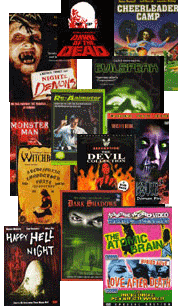 Werewolves. Deals with the devil. Bloodthirsty vampires. Seductive succubi luring men to their deaths. Mad scientists playing God.
Werewolves. Deals with the devil. Bloodthirsty vampires. Seductive succubi luring men to their deaths. Mad scientists playing God.
These are the standard tropes of horror, recycled again and again in thousands of stories and movies. Horror films, at their core, explore the most ubiquitous and powerful emotion – fear. Vampires, werewolves, giant man-eating Gila monsters — these represent agents of death we can’t control.
The horror movie allows us to see our fears magnified and most importantly, conquered. At their core, the vast majority of horror movies give us an adrenaline cocktail high, and then reassures us with a triumph of good over evil.
It’s no wonder, then, that both the most amateur and most accomplished directors explore the horror form. Many efforts slip (deservedly) into obscurity.
But as the long-running TV show “Mystery Science Theatre 3000” proved a decade ago, watching old horror movies that are too schlocky to be scary can be entertaining. The growing popularity of the DVD — and MST3000 — has led many film studios to comb through their old reels to unearth these over- and under-acted “classics” from the B-movie drive-in era of the ’50s and ’60s and beyond.
If you’re looking for a Halloween movie night, delving not into recent top-shelf horror movies like The Ring or The Others, but instead wanting to spend time with offbeat, low-budget “cult” movies from bygone eras, there is a dizzying array of options lurking on the shelves of your local Best Buy, Sam Goody or other video store.
I’ve previewed more than two dozen current horror reissues on DVD this fall, from ’50s-’60s drive-in style black and white movies to ’60s-’70s Italian horror and a potpourri of ’70s-’90s independent films.
These films all have in common: budgets. They are shoestring projects and often show it; but that’s part of their charm.
THE DEAD LIVE —THREE LOW-BUDGET CLASSICS:
One of the best-known movies in horror cinema is George Romero’s Night of the Living Dead
(![]()
![]()
![]()
![]() ), which focused on a disparate band of people trapped in an old farm house while zombies try to force their way inside.
), which focused on a disparate band of people trapped in an old farm house while zombies try to force their way inside.
Elite Entertainment has issued a Millennium Edition copy of this 1968 black and white independent classic that features a number of interesting bonuses, including reproductions of cast -member scrapbooks, video interviews, a short parody (Night of the Living Bread) and a commentary track with Romero and the cast talking about the hows and whys behind various scenes, and who still owns what props.
The video transfer on this DVD is superb, and it’s a tribute to the young director and cast that the movie remains effective and creepy 35 years after its initial release. The commentary track, which tells the story of how a group of struggling commercial-makers made this film in their off-time on a shoestring budget is as fascinating as the film itself.
 Another horror classic, while not nearly as well-known as Living Dead, is Carnival of Souls (
Another horror classic, while not nearly as well-known as Living Dead, is Carnival of Souls (![]()
![]()
![]() ).
).
This 1962 b/w movie was also made as a moonlighting effort by a group who worked as industrial filmmakers for a company in Lawrence, Kan. Shot for $30,000, the film was intended to be an “arty” horror movie, and follows a girl who emerges unscathed from a deadly drag-racing accident.
She leaves town to take a job as a church organist (the movie is filled with creepy organ backgrounds) and becomes haunted by the face of a ghoul and the lure of an abandoned Salt Lake City amusement park. While the film played a few drive-ins on its original release, it quickly vanished into obscurity for 20 years, before late-night television brought about a resurgence in its appreciation (and eventually, a disastrous color remake).
Like Night of the Living Dead, there are many versions of Carnival floating around at cheap discount prices. But do yourself a favor and find The Criterion Collection version. While pricier, the Criterion two-disc set offers the movie in both its theatrical release version and a “directors cut” version with five extra minutes.
It also includes an interesting commentary track by the screenwriter and director (recorded before his death), and a number of other bonuses. But the real value in Criterion’s version is in the quality of the video transfer. The picture quality, here, is crisp and clean with minimal film scratching. Other editions of this movie are loaded with flickers and film noise because they were probably created using an old copy of the film that had been damaged through hundreds of showings on late night TV.
Horror movies like Living Dead and Carnival are often most effective in black and white, because the monochromatic shadows play heavier on the imagination.
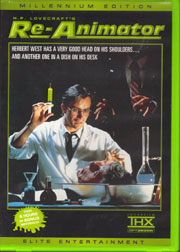 But one of the best low-budget color films you’re likely to find on the shelves is the 1985 release of H.P. Lovecraft’s Re-Animator (
But one of the best low-budget color films you’re likely to find on the shelves is the 1985 release of H.P. Lovecraft’s Re-Animator (![]()
![]()
![]()
![]() ).
).
The tagline for the film says it all: “Herbert West has a very good head on his shoulders … and another one in a dish on his desk.” This is your basic “mad scientist creates a miracle drug to bring the dead back to life” movie and it’s filled with over-the-top acting, a glow-in-the-dark life serum and deadly zombies. The plot is anchored by an ego-maniacal university professor and an equally obsessed young researcher (Herbert West, played by Jeffrey Combs).
A young couple end up caught in the deadly science-gone-wrong war between the two scientists. Elite’s edition of this must-see includes an extra discs-worth of bonus extras, from interviews to deleted scenes.
A BOX FROM TV’S PAST
W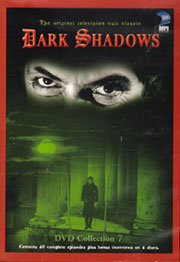 hile it’s not truly scary or a movie, it’s worth mentioning that many episodes of the original gothic vampire soap opera, Dark Shadows
hile it’s not truly scary or a movie, it’s worth mentioning that many episodes of the original gothic vampire soap opera, Dark Shadows
(![]()
![]()
![]() ), are now available on DVD. Released through MPI Video, a company based right here in the Chicago suburbs (Orland Park), the Dark Shadows DVD collection (a series of box sets) currently covers the first half of the ABC-TV show’s six-year run from 1966-1971.
), are now available on DVD. Released through MPI Video, a company based right here in the Chicago suburbs (Orland Park), the Dark Shadows DVD collection (a series of box sets) currently covers the first half of the ABC-TV show’s six-year run from 1966-1971.
Dark Shadows, while not always brilliantly acted, garnered a huge cult following and eventually spawned a remake series in its time-traveling, intrigue-drenched tales of Barnabas Collins, a guilt-ridden, 175-year old vampire, and his family. I watched a box set No. 7, including episodes from 1968, and while I hadn’t seen the show from the beginning, I was quickly caught up in the story, bad sets, stumbled dialogue, fake blood and all.
TURN YOUR LIVING ROOM INTO A DRIVE-IN
The premise behind Elite Video’s “Drive-In Discs” series is inspired. The Drive-In Discs Collection
(![]()
![]()
![]()
![]() ) boxed set includes six b/w films (all but one produced in 1960) on three DVDs. Three of these ended up being lampooned on MST3000 episodes. The features include The Giant Gila Monster, The Wasp Woman, The Giant Leeches, The Hand, I Bury the Living and The Screaming Skull, (the latter has an amazing number of screams in it considering the only prop is a skull that keeps turning up in odd places).
) boxed set includes six b/w films (all but one produced in 1960) on three DVDs. Three of these ended up being lampooned on MST3000 episodes. The features include The Giant Gila Monster, The Wasp Woman, The Giant Leeches, The Hand, I Bury the Living and The Screaming Skull, (the latter has an amazing number of screams in it considering the only prop is a skull that keeps turning up in odd places).
Each DVD also includes commercials and short cartoons that would have been played in between the movies if you actually saw these at a drive-in 30 or 40 years ago.
Remember the old “Let’s All Go to the Lobby” commercial to visit the theater’s refreshment stand? Or the “Chilly Dilly” pickle commercial? (It’s hard to believe today that pickles were a big seller along with popcorn!) You get those kitschy remnants and more on these discs, along with “Popeye” and “Betty Boop” cartoons and promos for other B-movies.
You can pop one of the DVDs in and let it run its programmed sequence of promos, cartoons and movies, or just select the individual features you want to see.
But are the movies watchable?
 I Bury The Living is among the best of the lot with its “Twilight Zone” tone and theme. When a new chairman takes over running the local cemetery, he visits the main office where a giant map of all the graves covers one wall. Graves that are filled, are marked with one color pin, while plots that have been sold but are not yet filled are marked by another color. When the new guy accidentally puts in the wrong color pin for a couple who’ve just bought a plot, they turn up dead the next day. And they’re just the first in a series of deaths attributed to the cemetery map pins.
I Bury The Living is among the best of the lot with its “Twilight Zone” tone and theme. When a new chairman takes over running the local cemetery, he visits the main office where a giant map of all the graves covers one wall. Graves that are filled, are marked with one color pin, while plots that have been sold but are not yet filled are marked by another color. When the new guy accidentally puts in the wrong color pin for a couple who’ve just bought a plot, they turn up dead the next day. And they’re just the first in a series of deaths attributed to the cemetery map pins.
The Hand is a forgettable English feature about former POWs who were faced with having their hands amputated by the Japanese if they didn’t provide secret information and the psychosis that one of them develops from the experience years later.
The Giant Gila Monster is slightly more watchable, if only for its amusing “daddy-o” hepcat language. When a gila monster unaccountably grows to gigantic proportions out in the wilderness, it starts hanging out by the side of the road to attack drivers.
As a horror movie, this one drags, even though it’s only 74 minutes long. The gila (it’s painfully obvious that it’s really a normal-sized lizard) is slow-moving and never particularly frightening. But some of the dialogue is fun.
B-movie king Roger Corman’s The Wasp Woman features an awful costume but another “Twilight Zone”-esque plot. A cosmetics mogul hires a scientist to create a fountain of youth serum using extracts from wasps. Not surprisingly, the serum works, but also has the tendency to turn its user into a humanoid wasp now and then. The scenes of Susan Cabot wearing a bad fuzzy headmask are hysterical (and where does that buzzing sound come from? She doesn’t have wings!). The Giant Leeches features similar bad costuming, as two man-sized leeches (in latex suits covered with octopus-like suction cups) terrorize those who live near a swamp.
MAD SCIENTISTS, VAMPIRES, WOLFMEN, OH MY!
S omething Weird Video (distributed by Image) offers a similar series of DVDs with two and three movies per disc. But while the Elite collection features movies that really were at the drive-in, some of Something Weird’s offbeat titles may not have been seen by more than the cast and crew. Something Weird reportedly bought a vault of old movie reels, many of which never were released at the time of their making.
omething Weird Video (distributed by Image) offers a similar series of DVDs with two and three movies per disc. But while the Elite collection features movies that really were at the drive-in, some of Something Weird’s offbeat titles may not have been seen by more than the cast and crew. Something Weird reportedly bought a vault of old movie reels, many of which never were released at the time of their making.
One of their titles is The Atomic Brain (![]() ½), another MST3000 entry originally titled Monstrosity. It’s an amusing 1963 feature wherein an old woman funds the work of a mad scientist interested in brain transfer.
½), another MST3000 entry originally titled Monstrosity. It’s an amusing 1963 feature wherein an old woman funds the work of a mad scientist interested in brain transfer.
She wants to move her aging intellect into the body of a pretty young girl, and to that end, hires three women (foreigners, so they won’t be missed) to come work at her house as servants.
While the opening is slow (the first 10 minutes are silent movie footage with a narrator), things do pick up, as the girls try to find a way out of the house, and the old woman stabs and threatens her way to transplantation time. Needless to say, she doesn’t end up in the body she wanted.
This disc also includes the horrible b/w exploitation film “Unsatisfied Love,” retitled here as Love After Death. When a wife gets her impotent husband buried alive so she can live with her new lover, he manages to crawl out of the grave. He then inexplicably stumbles like an out-of-place Where’s Waldo through a series of cheesy sexual situations (at one point he is come-hithered by a transvestite and two nude lesbians), until returning to his wife to exact his revenge.
This is pure trash cinema.
That’s followed by The Incredible Petrified World, a forgettable 1960 sci-fi movie, starring John Carradine, about divers who find a lost world under the sea where there’s really nothing particularly interesting, except a nasty guy with a fake beard.
Something Weird also offers a disc of forgotten ’70s films, The Thirsty Dead and The Swamp of the Ravens (each * ) The best thing about it isn’t either of the movies, but rather, the promos for other horror flicks, and a b/w episode from the Swedish TV show “13 Demon Street,” hosted by Lon Chaney Jr. The episode (filmed in English but with subtitles in Swedish) was written and directed by the late Curt Siodmak, creator of The Wolfman and Donovan’s Brain.
It follows the misadventures of a surgeon who loses his hand in a car accident and sews on a new one that, unfortunately, turns out to be from a serial killer. You can guess the deadly results.
As for the movies on the disc, The Swamp of the Ravens is a terribly muddy mad scientist film. It does have a couple of truly creepy sequences, including a section where the heads of zombies all rise to the surface of a swamp to stare at the scientist’s shack. Basically, the evil mad scientist is doing the usual “bring the dead back to life” schtick, and dumps all his failures in the swamp. When his girlfriend dumps him, she naturally becomes a part of his experiment (which leads to the film’s creepy gratuitous nudity/necrophilia scene).
The Thirsty Dead, about a cave-dwelling race who mix human blood with an herb to gain immortality, doesn’t know what it wants to be. There’s a bit of science fiction, with an ancient talking head in a glass box of red fluid. There’s a touch of horror, in the zombie-like victims of the blood drinkers. But neither element ever gels.
The movie does offer some room for laughs at the terrible sets and One Million Years B.C. meets “Flash Gordon” costumes. The plot is simple: Four women are kidnapped and brought to the caves to be “drank from.” One of them is invited to “join the immortals.” Naturally, they try to escape, and are inexplicably helped by one of the immortals who sacrifices himself for their freedom.
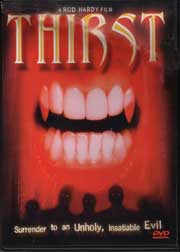 A better, and equally odd, vampire treatment comes in Elite’s issue of the 1979 movie Thirst (
A better, and equally odd, vampire treatment comes in Elite’s issue of the 1979 movie Thirst (![]()
![]() ), where a woman is kidnapped to join a cult of vampires. The kidnapped woman is supposed to be a descendant of the original vampire, and the cultists try to fool and condition her into drinking blood. Like the lead character in The Thirsty Dead, naturally she refuses and tries to escape. It’s not a great film, but there are some creepy sequences, and the notion of vampires who can walk by day at a modernized “dairy” where human victims are “milked” of their blood by machines is intriguing.
), where a woman is kidnapped to join a cult of vampires. The kidnapped woman is supposed to be a descendant of the original vampire, and the cultists try to fool and condition her into drinking blood. Like the lead character in The Thirsty Dead, naturally she refuses and tries to escape. It’s not a great film, but there are some creepy sequences, and the notion of vampires who can walk by day at a modernized “dairy” where human victims are “milked” of their blood by machines is intriguing.
An overlong but occasionally amusing movie is Elite’s reissue of director William Beaudine’s final film, 1966’s Jesse James Meets Frankenstein’s Daughter (![]() ). The first half of the movie is a basic Western about an unconvincing Jesse James, who ultimately stumbles on Frankenstein’s granddaughter’s lair (she’s naturally still trying to bring back the dead). This one’s slow and laughable, but is made more interesting if you listen to the commentary track by TNT’s B-movie host and guru Joe Bob Briggs, who goes into all sorts of details about the histories of the actors and director.
). The first half of the movie is a basic Western about an unconvincing Jesse James, who ultimately stumbles on Frankenstein’s granddaughter’s lair (she’s naturally still trying to bring back the dead). This one’s slow and laughable, but is made more interesting if you listen to the commentary track by TNT’s B-movie host and guru Joe Bob Briggs, who goes into all sorts of details about the histories of the actors and director.
Briggs also offers a thoughtful commentary on Elite’s Millenium issue of the rape-revenge shocker I Spit on Your Grave (![]()
![]() ), a film not for the young or squeamish. This 1978 shocker views almost like a documentary, and tells the story of a free-spirited woman who goes to the country and is tormented and raped in the forest and her cabin by a bunch of degenerates before she turns the tables and kills them one by one. On its original release, Ebert and Siskel’s damning newspaper columns got the film’s run cut short in Chicago (their reviews appear as extras on the DVD) but Briggs suggests that they missed the boat on this one and that it’s not an exploitation film, but a work of feminism.
), a film not for the young or squeamish. This 1978 shocker views almost like a documentary, and tells the story of a free-spirited woman who goes to the country and is tormented and raped in the forest and her cabin by a bunch of degenerates before she turns the tables and kills them one by one. On its original release, Ebert and Siskel’s damning newspaper columns got the film’s run cut short in Chicago (their reviews appear as extras on the DVD) but Briggs suggests that they missed the boat on this one and that it’s not an exploitation film, but a work of feminism.
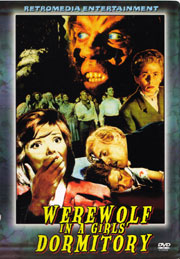 Image Entertainment/Retro-media offers a slew of low-budget films in its catalog, but how can you go wrong with a black and white 1961 Italian-filmed thriller called Werewolf in a Girls Dormitory (
Image Entertainment/Retro-media offers a slew of low-budget films in its catalog, but how can you go wrong with a black and white 1961 Italian-filmed thriller called Werewolf in a Girls Dormitory (![]()
![]() ½)?
½)?
It centers around a reform school for girls, and the unexplained murders that begin to occur when a doctor of questionable past comes to the school. Is the killer werewolf the doctor, who has been investigating werewolves? The school handyman, who looks like an “Igor” character? The cool, school headmaster? The teacher who was being blackmailed for his philandering by the first victim? This is a nicely atmospheric film, filled with creepy music and a good dose of whodunit. This DVD edition features a commentary track with the director talking about the making of the movie.
Horror goes abroad
I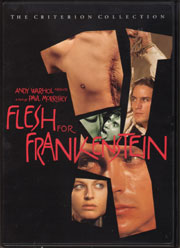 n the 1970s, many independent directors took their cameras and went to Italy or Mexico to shoot their shoestring productions, because it was cheaper to use unknown actors in exotic locales than to work at home. Paul Morrissey, who directed films for Andy Warhol, and eventually directed Warhol’s career as well, created two Italian-based horror films over an intense two-month period in 1974 – Andy Warhol Presents: Flesh for Frankenstein (
n the 1970s, many independent directors took their cameras and went to Italy or Mexico to shoot their shoestring productions, because it was cheaper to use unknown actors in exotic locales than to work at home. Paul Morrissey, who directed films for Andy Warhol, and eventually directed Warhol’s career as well, created two Italian-based horror films over an intense two-month period in 1974 – Andy Warhol Presents: Flesh for Frankenstein (![]()
![]()
![]() ½) and Blood for Dracula. (
½) and Blood for Dracula. (![]()
![]()
![]() ) Morrissey shot the films back to back, using many of the same actors (German-accented Udo Kier plays both Dracula and Frankenstein). While low-budget productions (each cost less than $300,000), both films are artfully shot, well scored with quiet, effective orchestral themes and use humor and sex to turn the horror genre on its ear. The Criterion Collection has reissued both films on DVD, uncut, with fascinating commentaries by the director, Kier and film historian Maurice Yacowar.
) Morrissey shot the films back to back, using many of the same actors (German-accented Udo Kier plays both Dracula and Frankenstein). While low-budget productions (each cost less than $300,000), both films are artfully shot, well scored with quiet, effective orchestral themes and use humor and sex to turn the horror genre on its ear. The Criterion Collection has reissued both films on DVD, uncut, with fascinating commentaries by the director, Kier and film historian Maurice Yacowar.
Flesh for Frankenstein is the more “fun” of the two films, revelling in excess. Morrissey shot it in 3-D, with an abundance of nudity and blood (which fountains out of severed limbs in as fake a fashion as it does in a Monty Python film). In the movie, Morrissey paints Frankenstein and his wife as a married brother and sister who continue an incestuous family tradition. The entire film examines the disintegration and isolation of individuals in the modern family unit, as the two voyeuristic children never speak, Mrs. Frankenstein busies herself with extramarital relations and Mr. Frankenstein abhores traditional sex but finds ecstasy in putting his hands inside his experimental corpses. Frankenstein’s goal is to create the perfect male and female from body parts and have them mate to produce the perfect race. When he cuts the head off a prospective monk instead of a sex-starved man to finish his male monster, his plans begin to fall apart. In the backdrop of all this are the two creepy children, who are clearly learning to grow up and be as twisted and dysfunctional as their parents. There’s a wealth of gore and nudity in Flesh For Frankenstein, but unlike many horror movies, Morrissey also has something to say thematically in the film.
His followup, Blood for Dracula, finds the celebrated fictional count needing to travel to Italy to find a “wergin” to re-energize himself (apparently he and his sister have drank Romania dry of virgins). Unfortunately, he picks a bankrupt noble family whose daughters have been “slumming” with the hired help, and their blood makes him (literally) ill. This is a slower, more poetic movie than Frankenstein, and deals with themes of classicism and false appearances. It also features a guest appearance by Roman Polanski, who originally suggested that Morrissey film Frankenstein in 3-D.
 For a less arty, more exploitative glimpse of early ‘70s Italian horror, Image offers England’s Redemption Films box set, The Devil Collection.(
For a less arty, more exploitative glimpse of early ‘70s Italian horror, Image offers England’s Redemption Films box set, The Devil Collection.(![]()
![]() ½)
½)
Nude for Satan and The Sinful Nuns of Saint Valentine were both shot in Italian in 1974 and are presented here with subtitles or overdubbed English. The third film, 1971’s Devil’s Nightmare, was shot in English, but the dialogue was re-recorded and so occasionally the lips don’t quite match the words. Both “Nude” and “Nightmare” rely on people stranded at a spooky house as their jump-off point.
Nude for Satan, aside from its copious gratuitous female nudity, actually includes some very spooky scenes, as two victims of a car accident wander through a strange house and are confronted with the “evil” sides of the other victim as the demonic landlord looks on.
Devil’s Nightmare finds a group of people stranded at a castle haunted by a succubus. As the night goes on, she traps each of the tourists in a mortal sin (lust, greed, gluttony) and steals their souls for the devil – until a man studying to be a priest makes a counter-deal with the devil for their souls.
The third film in the set, The Sinful Nuns of Saint Valentine isn’t a horror film as much as just a strange film – in it, a Romeo and Juliet story plays out between a convict and a girl sent to convent against her will and a mother superior of the convent who seems far more concerned with S&M punishment than religion. These are interesting period pieces, but certainly not for children.
Recent revivals:
J ust five years ago, cult horror director Dario Argento created a lush revival of Phantom of the Opera, (
ust five years ago, cult horror director Dario Argento created a lush revival of Phantom of the Opera, (![]()
![]()
![]() ) with his daughter Asia, and Julian Sands in the pivotal roles. While the movie didn’t make a splash at theaters, it’s worth picking up the Ardustry DVD of the film. Argento, whose 1970s film “Suspiria” is a classic of the horror genre, takes the concept of the Phantom as a disfigured monster and turns it on its ear. Julian Sands instead plays the Phantom as an externally elegant, darkly romantic figure who is internally disfigured, thanks to being abandoned as a baby and raised in the sewers by rats. When he wins the heart of the young opera singer (Asia Argento), he tries to forcibly help her career and imprison her to his will, and thus dooms their chances of happiness.
) with his daughter Asia, and Julian Sands in the pivotal roles. While the movie didn’t make a splash at theaters, it’s worth picking up the Ardustry DVD of the film. Argento, whose 1970s film “Suspiria” is a classic of the horror genre, takes the concept of the Phantom as a disfigured monster and turns it on its ear. Julian Sands instead plays the Phantom as an externally elegant, darkly romantic figure who is internally disfigured, thanks to being abandoned as a baby and raised in the sewers by rats. When he wins the heart of the young opera singer (Asia Argento), he tries to forcibly help her career and imprison her to his will, and thus dooms their chances of happiness.
Ardustry has also reissued a clearly direct-to-video remake of The Mummy. (![]() ) This 1997 production with Louis Gossett, Jr. updates the classic story of tomb-robbing that yields a deadly curse to the modern day, but the movie’s main point of interest isn’t the weak, dull plot, but the amusing appearance of Richard Karns (of “Home Improvement” fame). Don’t mistake this one for the 1999 Brendan Fraser action-adventure vehicle.
) This 1997 production with Louis Gossett, Jr. updates the classic story of tomb-robbing that yields a deadly curse to the modern day, but the movie’s main point of interest isn’t the weak, dull plot, but the amusing appearance of Richard Karns (of “Home Improvement” fame). Don’t mistake this one for the 1999 Brendan Fraser action-adventure vehicle.
Image Entertainment has reissued the early ‘80s killer alien movie Biohazard, (![]() ½) which is a terrible movie, but worth seeing for a good laugh. This film has some of the worst, most wooden dialogue I’ve seen in years, not to mention horrible special effects. It opens with a scientist showing one-dimensional military morons how a psychic, hooked up to a silly gizmo, can transport things from outer space (or somewhere) into the room. When the military tries to walk away with a coffin-sized artifact she’s transported, they naturally end up loosing a crablike humanoid alien. For some reason, all of the people this alien slashes with its claws foam at the mouth (must have been a special on green foam at the trick shop that week). This one’s silly from start to finish, but in the right frame of mind, it’s fun too.
½) which is a terrible movie, but worth seeing for a good laugh. This film has some of the worst, most wooden dialogue I’ve seen in years, not to mention horrible special effects. It opens with a scientist showing one-dimensional military morons how a psychic, hooked up to a silly gizmo, can transport things from outer space (or somewhere) into the room. When the military tries to walk away with a coffin-sized artifact she’s transported, they naturally end up loosing a crablike humanoid alien. For some reason, all of the people this alien slashes with its claws foam at the mouth (must have been a special on green foam at the trick shop that week). This one’s silly from start to finish, but in the right frame of mind, it’s fun too.
John Everson is The Star’s Pop Stops music columnist, as well as the author of the short horror fiction collection Vigilantes of Love (Twilight Tales).





